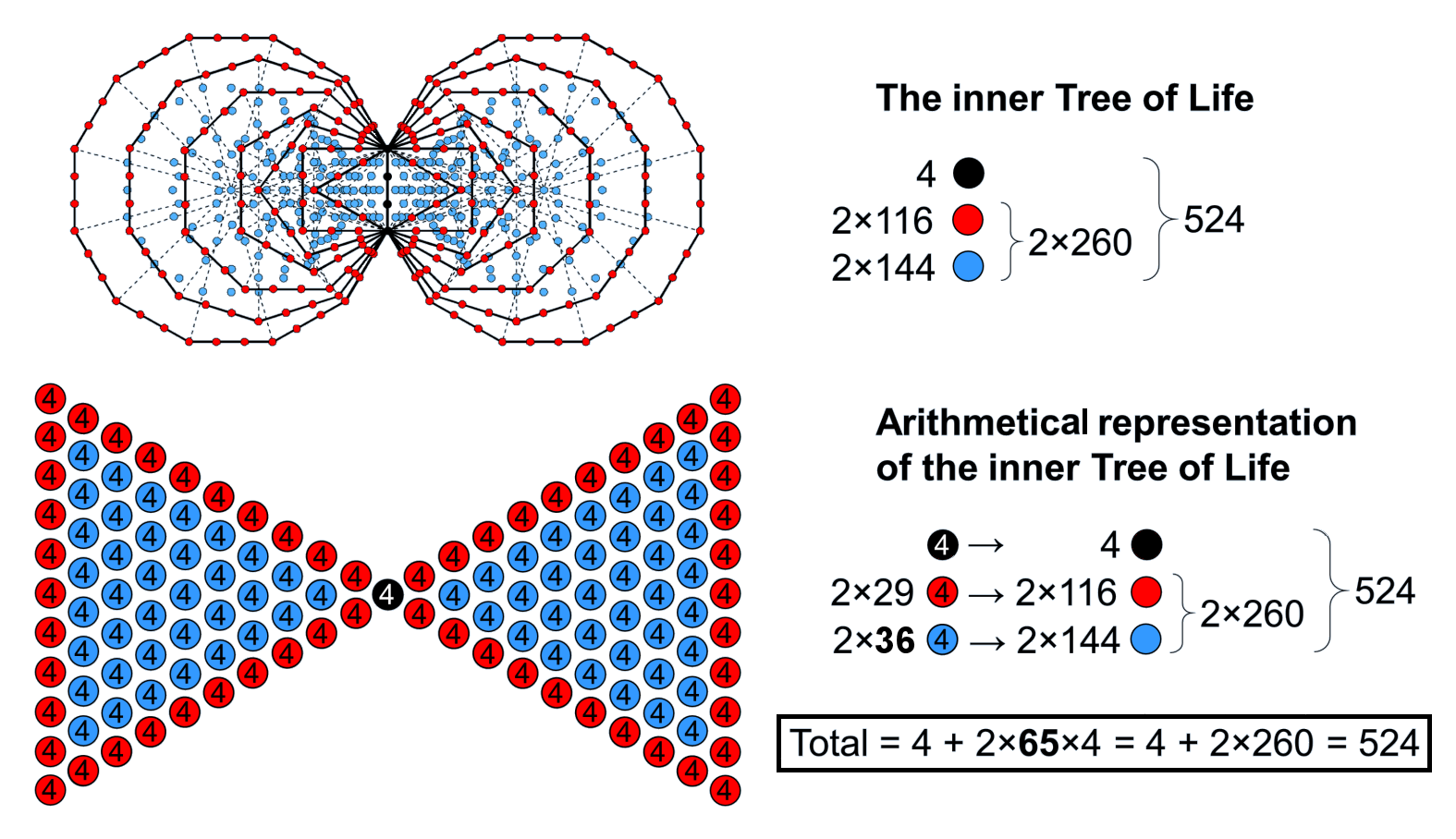
| << Previous 1... 77 78 79 80 [81] Next >> |
#81 An arithmetic representation of the inner Tree of Life

The (7+7) enfolded Type A polygons of the inner Tree of Life have 524 yods. Four black yods line the root edge shared by all 14 polygons. Outside it are 260 yods in each set of seven enfolded polygons. This is the number of yods in 26 tetractyses, showing how YAHWEH, the Godname of Chokmah with number value 26, prescribes the yod population of each half of the inner Tree of Life. The seven polygons in each half have 36 corners and 42 sides, where 36 is the number value of ELOHA, the Godname of Geburah. The number of yods lining their boundaries = 36 + 2×42 = 120 = 112 − 1
= 3 + 5 + 7 + 9 + 11 + 13 + 15 + 17 + 19 + 21,
i.e., 120 is the sum of the first 10 odd integers after 1. The number of boundary yods outside the root edge = 120 − 4 = 116. They are coloured red in the diagram above. Inside their boundaries are (264−120=144) blue yods, where 144 = 122 and 12 is the number of corners of the dodecagon, the tenth regular polygon. The Decad (10) determines the boundary and interior of the inner Tree of Life. This 120:144 division is the counterpart to the distinction in the outer Tree of Life between its trunk and its branches. It manifests in the Polyhedral Tree of Life as the 120 faces of the disdyakis triacontahedron and the 144 faces of the 144 Polyhedron, which are the polyhedral counterparts of, respectively, the trunk and branches of the outer Tree of Life.
The pattern of numbers of yods:
524 = 4 + 2×260 = 4 + 2×(116+144)
has an arithmetic counterpart, as now explained. The 11th triangular number is a triangular array of
1 + 2 + 3 + 4 + 5 + 6 + 7 + 8 + 9 + 10 + 11 = 66
points. If every point is replaced by the Pythagorean Tetrad (4), the sum of the 66 4's is 264, which is the number of yods in the seven enfolded Type A polygons. The sum of the 65 4's below an apex of the triangular is 260, which is the number of yods outside the root edge of these polygons. The number 65 is the number value of ADONAI, the Godname of Malkuth. There are 30 4's lining the boundary of the triangle, that is, 29 4's other than the integer 4 at one corner. Their sum is 116, which is the number of yods on the sides of the seven enfolded polygons outside their root edge. There are 36 4's inside this boundary that add up to 144; this is the number of yods inside the boundaries of the seven enfolded polygons making up each half of the inner Tre of Life. Two triangular arrays of 66 4's sharing one corner reproduce the boundary and internal yod populations of these halves. They consist of 131 4's, where 131 is the number value of Samael, the Archangel of the Sephirah Geburah. The number values of both the Godname and the Archangel of the same Sephirah, namely, Geburah, are present in this pattern. 131 is the 65th odd integer after 1. The Tetrad gives this number a unique significance vis-à-vis the inner Tree of Life because the yod population of the latter = 524 = 131×4. The 72 internal 4's add up to 288, which is the number of yods inside the sides of the (7+7) enfolded polygons. The number 72 is the number value of Chesed, the Sephirah preceding Geburah. The number of 4's surrounding the linking one is 130, where
| 130 = |
15 + 25 + 35 + 45 |
|
1 + 2 + 3 + 4 |
This pattern of 4's can be regarded as an arithmetic representation of the inner Tree of Life, the two triangular arrays expressing its two halves. The 4's at the two corners of each array can be thought of as denoting the eight yods that line each square outside the root edge that they share, the square being, of course, the symbol of the number 4. The three 4's at the corners of the triangular array therefore express the 12 yods that line the square when — together with the other polygons — it is constructed from tetractyses.
| << Previous 1... 77 78 79 80 [81] Next >> |